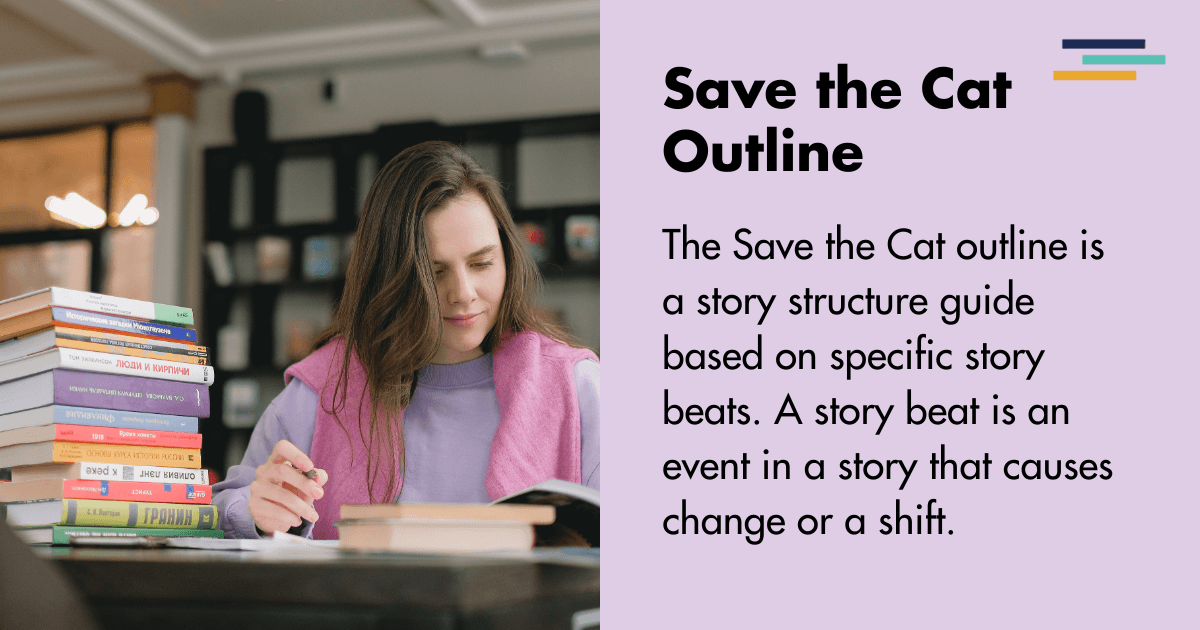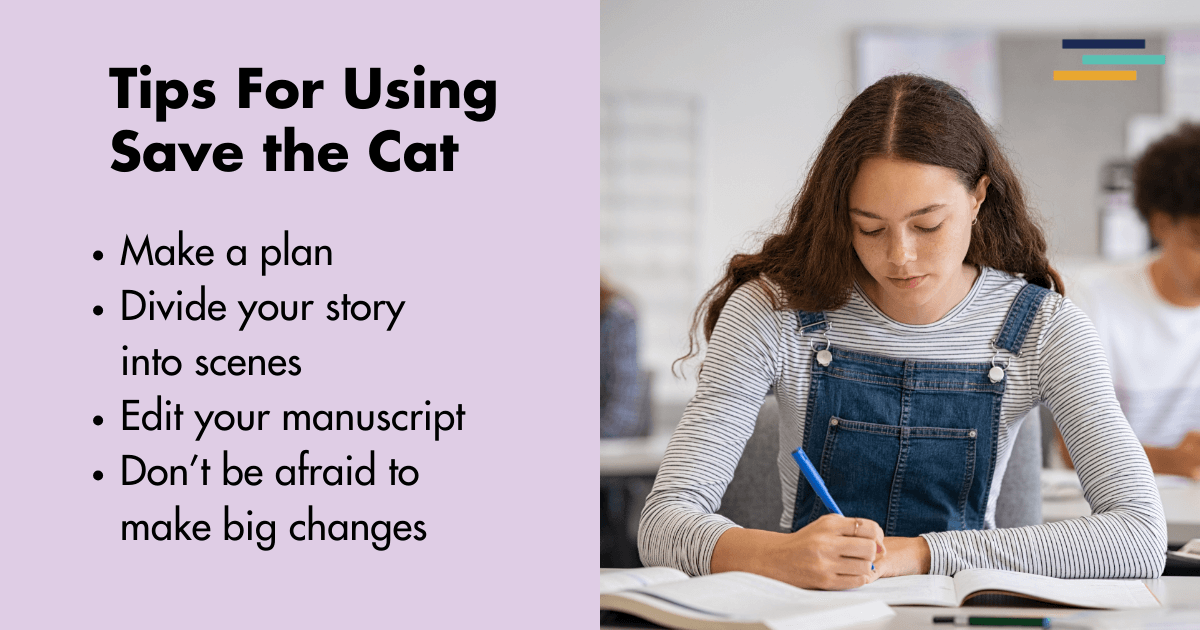
In this article we’ll examine the Save the Cat story outline, look in detail at how this outline compares with a successful novel, and explore some tips for how to use the outline to draft and edit your own story.
What Is the Save the Cat Outline?
The Save the Cat outline is a story structure guide based on specific story beats. A story beat is an event in a story that causes change or a shift.
The outline was created by Blake Snyder, who developed it through analyzing the structures of commercially successful movies. The outline was then developed by Jessica Brody, who used the same methodology in the context of successful novels.
The guidance provided by the Save the Cat outline has found huge popularity with writers and story structure enthusiasts alike, as a quick look at the many glowing reviews for Jessica Brody’s book demonstrates.
Save the Cat is a story structure that can be used in conjunction with the three-act structure used in Fictionary Storyteller software. To read more about how the Save the Cat structure works alongside the three-act structure, check out Kristina Stanley’s blog.
The Save the Cat story structure requires a writer to meet 15 beats at specific percentage points of their story’s narrative.
If you’re a pantser rather than a planner and prefer to write your stories as they flow, don’t assume that you won’t still enjoy studying this story structure. Save the Cat can still be a lifesaver for pantsers.
If a pantser struggles to know where the characters should take the story at any point, they can turn to Save the Cat to seek inspiration. Or they can write their story from start to finish, and then turn to Save the Cat to see which areas they may need to look at when structurally editing their story.
So, let’s look at what the 15 story beats are.

Save the Cat Story Structure
Act One: Opening Image (0-1%)
The opening image provides a snapshot view of who your protagonist is and what their world is like before the story starts. You’ll want this opening image to act as an entry hook for your story.
Act One: Theme Stated (5%)
At some point in the story’s first 5 percent, someone will make a statement which hints at what the protagonist needs to learn in order to achieve their story goal at the story’s climax.
Act One: Setup (1% to 10%)
Within the first 10 percent, you’ll want to show (and not just tell) the protagonist’s ordinary world, their story goal, how they’ll need to change if they’re to achieve their goals, and what the stakes are if they fail to do so.
You’ll want to introduce supporting characters and set-up what your reader needs to know of your story world to understand the plot and characters.
Act One: Catalyst (10%)
This is an inciting incident scene, a single-beat scene that catapults the protagonist into a new world or way of thinking. It should be clear that the protagonist cannot return to their ordinary world.
Act One: Debate (10% to 20%)
This is a sequence of scenes in which the protagonist reacts to the inciting incident, debating whether or not to take up the challenge of achieving their perceived or real story goal. In this beat, you should show how and why your protagonist is reluctant to change and why they will find their goal particularly difficult to achieve.
Act Two: Break into 2 (20%)
The protagonist takes decisive action as they accept the call to action towards their story goal, venturing into a new world or way of thinking.
Act Two: B Story (22%)
Here, a new character or characters enter who will help the protagonist learn how they need to change by the story’s end. These can be love interests, nemeses, mentors, family members, or friends.
Act Two: Fun and Games (20% to 50%)
The protagonist will be interacting with their world in this multi-beat sequence of scenes. It may be fun for the protagonist, or they may hate it, but regardless, this section should be fun for the reader!
This section should answer the promises you made in your story’s hook: if you promised action, provide action. If you promised romance, show romance. If you promised fantasy, explore the new magical world thoroughly.
Act Two: Midpoint (50%)
At the middle of the novel, the Fun and Games section leads either to a single-beat false victory or a false defeat. This should raise the stakes, ensuring that the protagonist has no option but to proactively pursue their story goal.
Act Two: Bad Guys Close In (50% to 75%)
During this multi-beat sequence, the protagonist has yet to address their inner flaws, and so as they actively seek their goal, they’ll nevertheless be unable to achieve it.
If your Midpoint was a false victory, at this stage things will grow progressively worse for your protagonist.
If the Midpoint was a false defeat, things will seem to get progressively better, but the protagonist’s failure to change will keep holding them back from complete success.
Act Two: All is Lost (75%)
This is an action single-beat scene that represents the low-point for the protagonist, which has occurred because of the protagonist’s failure to change their inner flaws.
Act Two: Dark Night of the Soul (75% to 80%)
A scene or series of scenes in which the protagonist finally, in reaction to their low-point, addresses their inner flaws and needs to change.
This is when the protagonist starts to learn the theme of the novel.
Act Three: Break Into 3 (80%)
This is the single-beat ‘aha!’ moment when the protagonist realizes that to achieve their story goal, they’ll need to fix themselves first.
Act Three: Finale (80% to 99%)
Using the plan devised in Break Into 3, over a series of climactic scenes the protagonist will now have to prove, through their actions, that they’ve learned what they need to have learned.
In most modern commercial novels, this lesson learned is likely to result in the protagonist achieving either their real or perceived story goal.
If your story is a tragedy, a work of literary fiction, or carries an ironic or bittersweet message, then the protagonist may fail to learn this lesson in time.
Act Three: Final Image (99% to 100%)
This provides a mirror to the opening image, showing the after image in contrast with the before.
Example of a Save the Cat Beat Sheet
As an example, I’ll analyze Holly Black’s successful YA fantasy novel The Cruel Prince against the Save the Cat story beats. Be warned that there are spoilers for this book coming up.
Opening Image
Seven-year-old Jude is at home with her two sisters when a stranger comes to her door, killing both her parents. He claims to be Jude’s older sister’s real father, and abducts the three children, taking them to Fairieland.
Theme Stated
In the first 5%, Tatterfell, a servant imp, warns Jude that to seek to win her place at the High Court through her physical fighting skills is foolish. As the story progresses, Jude learns she must develop her strategy skills in order to make a strong position for herself as a human at the Fairie Court.
Setup
Treated as second-class citizens of Faerieworld, Jude and her twin-sister Taryn are bullied mercilessly by the Faerie Prince Cardan.
Jude desires to win the King’s tournament to best her tormentors and gain power and agency for herself.
Catalyst
Jude declares her wish to become a knight to her family, but is forbidden from fighting in the upcoming tournament by Madoc, her faerie father.
Madoc gives Jude new knowledge of the Faerie Court politics, explaining how the King will shortly pass his crown to his third son, Prince Dain. This knowledge of how the upcoming succession works will influence Jude’s actions for the rest of the story.
Debate
Jude and her twin-sister are bullied at faerie school by Prince Cardan. Jude reflects on all the ill-treatment she’s suffered in this world.
Her older sister Vivien takes Jude to the mortal world, suggesting they move back there together. However, Jude instinctively and violently lashes out at a stranger whilst there.
As a result, she decides she’s now so violent that she no longer belongs in the mortal world.
Break into 2
Jude publically stands up to Prince Cardan at the tournament, refusing to surrender to him. It’s now clear to everyone that she desires agency for herself in Faerieland, and will not give in to bullies, no matter their rank, title, magical ability, or superior strength.
There’s now no turning back from the fact she’s made an enemy of Prince Cardan.
B Story
Prince Cardan’s friend Locke speaks admiringly to Jude after she stands up for herself.
Fun and Games
Here, the story’s promise of magic, action, and romance is fulfilled as Jude explores the Faerie Court.
Jude swears herself into the service of the heir to the crown, Prince Dain. He grants her the power to resist enchantment in return for her service as a spy.
Locke and Jude grow close romantically.
Whilst spying, Jude realises her nemesis Prince Cardan suffers violent abuse from his older brother, Prince Balekin.
Midpoint
Jude rescues an enchanted human girl from Faerie enslavement (false victory).
She decides that once she gains influence upon Prince Dain’s ascension, she’ll use her power to stop faeries abusing humans.
The stakes have raised, as now Jude realizes that she can make a better world for all enslaved humans in Faerieland, upon gaining power for herself at Court.
Bad Guys Close In
The rescued human girl is so traumatized she kills herself. It’s now apparent that Jude’s seeming victory at the Midpoint was a false one.
Things now start growing worse for Jude.
At the coronation, her employer Prince Dain, and most of his family, are massacred by Prince Balekin and Jude’s fairy ‘father’ Madoc. The only two potential kings are both fairies Jude knows will treat humans badly: Cardan and Balekin.
Jude decides that Balekin is the worst option of the two, and abducts Cardan. She knows he’s the only person who can stop Prince Balekin from taking the throne.
All is Lost
Jude discovers Locke is cheating on her with her twin-sister Taryn. The two girls fight violently. Taryn accepts Locke’s marriage proposal.
Dark Night of the Soul
Her sister Vivian offers Jude a home in the mortal world again, but Jude realizes she cannot leave Taryn to Locke’s mercies, for he’ll surely hurt her.
Jude realizes that Madoc’s plan was to put their supposed younger brother, Oak, who’s actually a secret blood heir to the kingdom, onto the throne instead. Madoc would then rule as regent.
Break Into 3
Jude decides Faerieland is her true home. She chooses to fight to ensure the best possible King is crowned, and that won’t be Balekin.
Finale
Jude and Prince Cardan talk now he’s her prisoner. He reveals he hates her because he’s jealous of her, but he’s also uncomfortably attracted to her.
They agree he’ll help Jude crown her brother Oak as King. Cardan agrees to swear himself to Jude’s service, but only for a year and a day. In return, she’ll grant him his greatest desire: the freedom to live far from the responsibilities of Court’s politics.
Jude gathers allies at the Court.
At the Coronation, Jude double-crosses Cardan at the last minute, ensuring that he (not Oak) is crowned King of Faerie. Having sworn himself to Jude’s service, Cardan cannot refuse the crown.
Jude now has almost complete control of the crown herself, since Cardan’s oath to her ensures he must do as she bids him.
But her power will last only for a year and a day… (leading to Book 2!)
Final Image
Jude sends her younger brother Prince Oak to the mortal world with Vivien, where he can grow up far from the Court’s corruptions.
This shows a clear mirror image of Jude’s abduction into Faerieland as a child.

Tips for Using the Save the Cat Plot Structure
Make a Plan
Figure out where the story beats should come in your manuscript.
If you’ve written a complete manuscript already, look at your total word count. Figure out where the relevant percentage points (and corresponding story beats) fall in your narrative.
If you’re writing the first draft, research the average word count for your genre. Decide approximately how many words you intend your story to consist of. Then calculate the ideal word count you should reach at each percentage point/ beat.
Divide Your Story into Scenes
If you’re at the editing stage, figure out where your manuscript should divide into scenes. (Fictionary Storyteller software will assist you here.)
A new scene is likely to occur each time the point-of-view (POV) character changes, where the POV character’s scene goal changes, where the location changes, or sometimes when a new character enters the action.
Edit Your Manuscript
Save the Cat outline allows for some single-scene beats (e.g. All is Lost) and some multi-scene beats (e.g. Fun and Games). It’s particularly important that single scene beats come at the required percentage point in your manuscript.
If drafting, you may wish to write these key single-beat scenes first and ensure that the rest of your narrative fits around them.
If you’ve written your draft without a structure, now examine your manuscript. Look first for the key single-scene beats. Figure out whether your narrative meets these important structural beats at the relevant percentage point as advised by the Save the Cat beat-sheet.
When structurally editing your story, you may need to move certain scenes around to ensure the key scenes fall at the required percentage points. This may require some creative editing on your part, and you may need to rewrite certain scenes as a result of moving them.
For example, if your protagonist only begins to debate whether or not to accept their story goal at the 45 percent mark of your story, consider whether moving this debate scene sequence to your narrative’s 15 percent mark might improve your story’s pacing.
You may need to do some substantial revision to the following scenes, but the subsequent improvement to your story’s pacing may be worth the additional work.
Conclusion
Save the Cat is a popular and proven structural guideline for strengthening a narrative’s pacing. It provides valuable knowledge for writing and editing stories.
If you’d like to study the outline further, I’d highly recommend Jessica’s Brody’s seminal book, Save the Car Writes a Novel.


